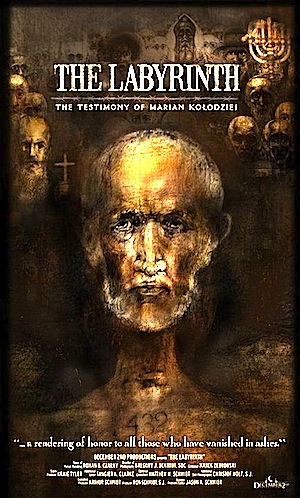By Joe Bendel. Marian Kołodziej’s art is not merely art, but testimony of the unimaginable. It is displayed not in a gallery, but in a labyrinth nestled beneath a small Polish church near Kołodziej’s former residence, Auschwitz. Through his darkly distinctive art, Kołodziej bears witness to the Holocaust in Jason A. Schmidt’s documentary The Labyrinth, which screens this Saturday as part of the shorts program at the 2011 John Paul II International Film Festival in Miami (as well as at the Boulder International Film Fest on the same day).
 A youthful member of the Polish resistance, Kołodziej, number 432, was one of the first prisoners at Auschwitz, who were forced to build its architecture of death. Surviving the ordeal, he established a successful career as a set designer, but almost never discussed his horrific experiences. However, when Kołodziej began drawing as part of his therapy for a considerable stroke, the ominous images of the concentration camp came bursting forth.
A youthful member of the Polish resistance, Kołodziej, number 432, was one of the first prisoners at Auschwitz, who were forced to build its architecture of death. Surviving the ordeal, he established a successful career as a set designer, but almost never discussed his horrific experiences. However, when Kołodziej began drawing as part of his therapy for a considerable stroke, the ominous images of the concentration camp came bursting forth.
Explaining the real life sources of his work, Kołodziej’s stories are mostly harrowing, but in rare instances also inspiring. The artist movingly pays tribute to Father Maximilian Kolbe, the Catholic priest who was canonized as a “martyr of charity” for taking the place of another man condemned to die in a starvation chamber. In drawings that are particularly powerful but just as gruesome, Kołodziej often depicts Kolbe comforting his fellow prisoners.
Almost Boschian in their nightmarish detail, Kołodziej’s work conveys the true nature of the Holocaust more compellingly and directly than any narrative feature could ever hope to. No matter how well intentioned or painstakingly produced, audiences are always conscious of a film’s artifice on some level. After two hours screen time, everyone goes back to life as usual. By contrast, each of Kołodziej’s pieces is a moment of agony frozen for all eternity. One can avert one’s eyes, but it will always be there as a silent indictment of the National Socialists’ crimes against humanity.
Respectfully crafted, Schmidt lets Kołodziej’s drawings and words (heard in translation) speak for themselves. Elegant in the simplicity of its approach, the thirty-eight minute Labyrinth is a hauntingly poetic documentary. It is also a perfectly fitting selection for the John Paul II Festival, considering that it was the Polish pontiff who canonized Kolbe and strived to improve the Catholic-Jewish relations throughout his tenure. Highly recommended, it screens this Saturday (2/19) at the FIU Marc Pavilion as part of the JP2FF’s shorts program.
Posted on February 17th, 2011 at 11:09am.
One thought on “LFM Reviews The Labyrinth at The John Paul II International Film Festival”
Comments are closed.